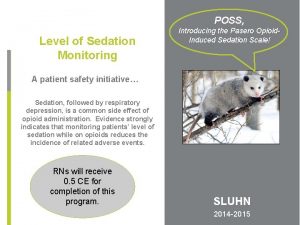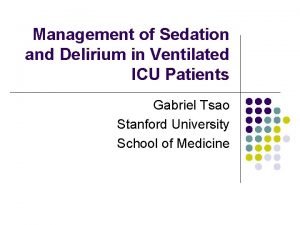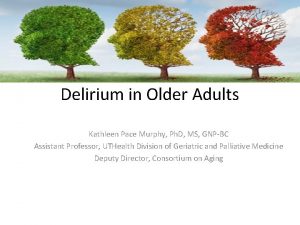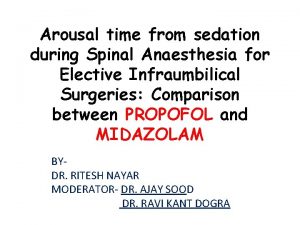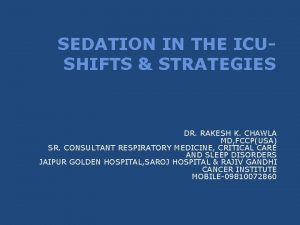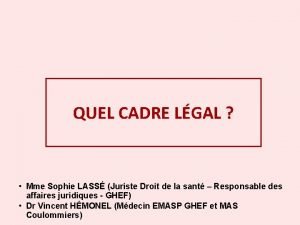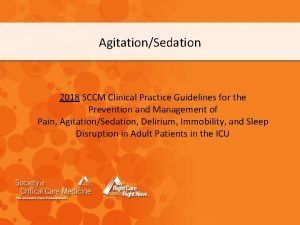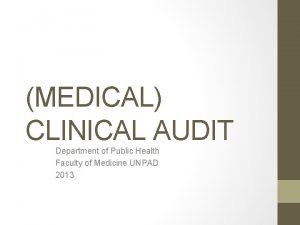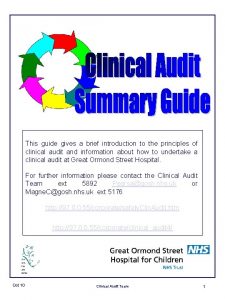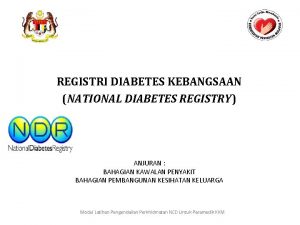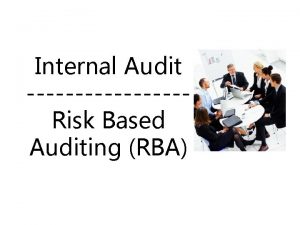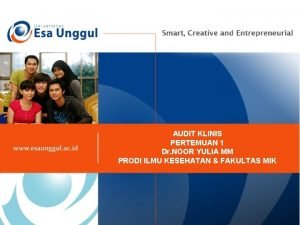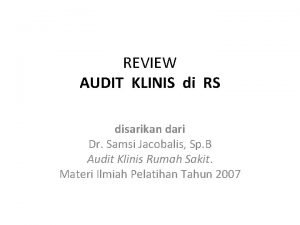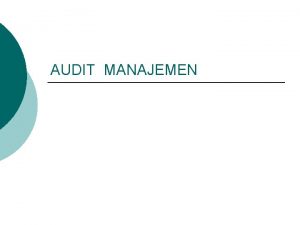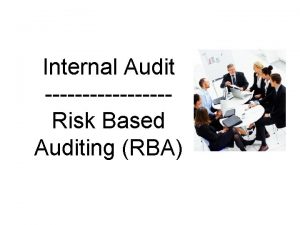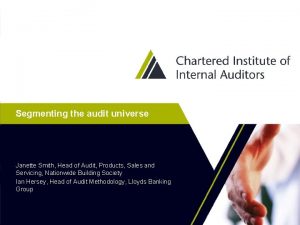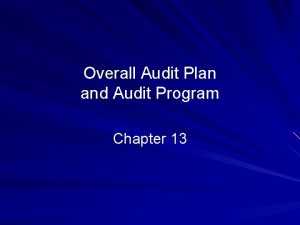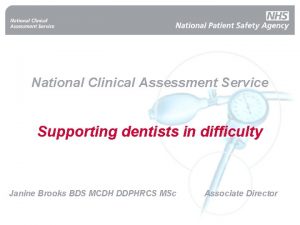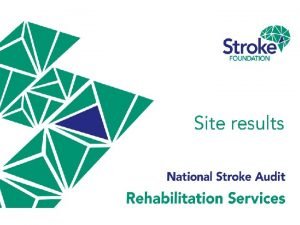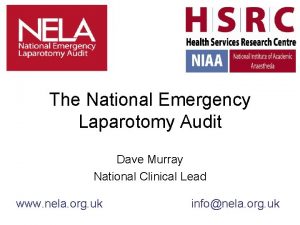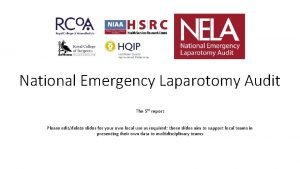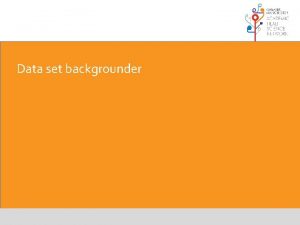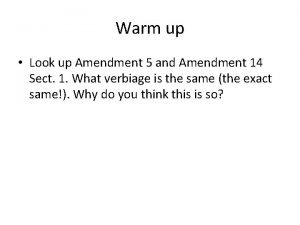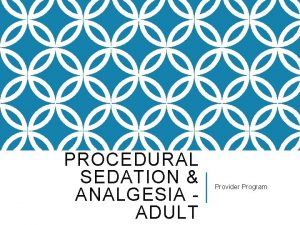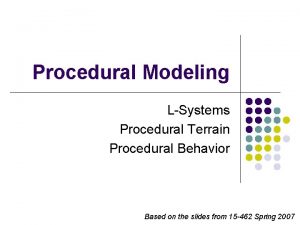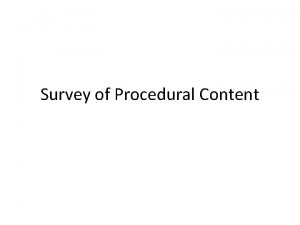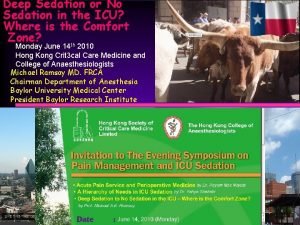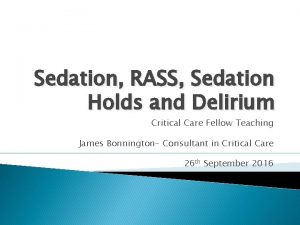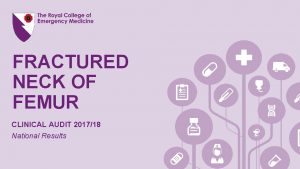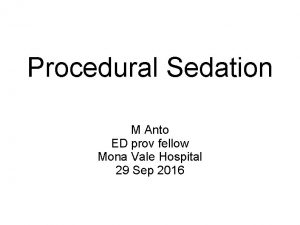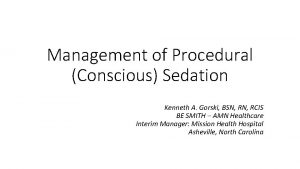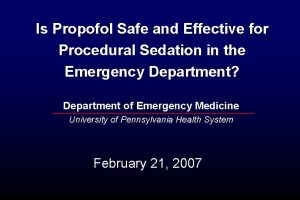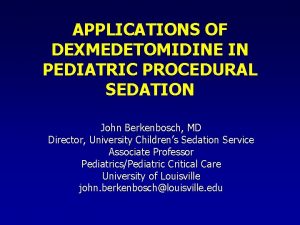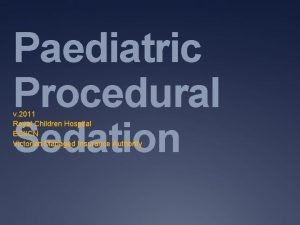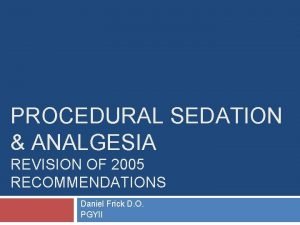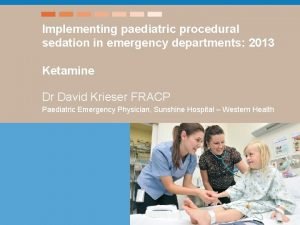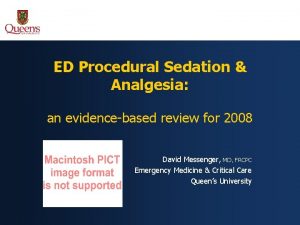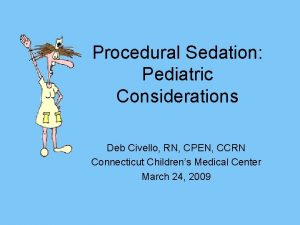PROCEDURAL SEDATION IN ADULTS CLINICAL AUDIT 201718 National






























- Slides: 30

PROCEDURAL SEDATION IN ADULTS CLINICAL AUDIT 2017/18 National Results

Contents • This presentation shows how EDs are performing against the audit standards. • For further information please see the national report at www. rcem. ac. uk/audits.

Audit objectives • To benchmark current performance in EDs against RCEM/RCo. A and Ao. MRC clinical guidance • To allow comparison nationally and between peers • To identify areas in need of improvement • To compare against previous performance

Standards Standard type 1. Patients undergoing procedural sedation in the ED should have documented evidence of pre-procedural assessment, including: a. ASA grading b. Prediction of difficulty in airway management c. Pre-procedural fasting status Fundamental 2. There should be documented evidence of the patient’s informed consent unless lack Developmental of mental capacity has been recorded. 3. Procedural sedation should be undertaken in a resuscitation room or one with dedicated resuscitation facilities. Fundamental 4. Procedural sedation requires the presence of all of the below: a. A doctor as sedationist b. A second doctor, ENP or ANP as procedurist c. A nurse Fundamental

Standards Standard type 5. Monitoring during procedural sedation must be documented to have included all of the below: a. Non-invasive blood pressure b. Pulse oximetry c. Capnography d. ECG Fundamental 6. Appropriate oxygen therapy should be given from the start of sedative administration Developmental until the patient’s condition is returned to baseline. 7. For invasive procedures, a Local Safety Standard for Invasive Procedures checklist (Loc. SSIP) or Nat. SSIP compliant checklist is used. Developmental

Standards Standard type 8. Following procedural sedation, patients should only be discharged after documented formal assessment of suitability, including all of the below: a. Return to baseline level of consciousness Fundamental b. Vital signs within normal limits for the patient c. Absence of respiratory compromise d. Absence of significant pain and discomfort e. Written advice on discharge for all patients

Executive summary • This graph shows the median national performance against standards for this audit • ↑ Higher scores (e. g. 100%) indicate higher compliance with the standards and better performance.

National Results 2017/18 (8815 cases) Lower quartile Median Upper quartile Median 2015/16 12% 34% 50% 8% 46% 68% 82% 52% 75% 93% 98% 91% RCEM Standard Summary of national findings STANDARD 1: Patients undergoing procedural sedation in the ED should have documented evidence of pre-procedural assessment, including: a. ASA grading, b. 100% Prediction of difficulty in airway management, c. Preprocedural fasting status STANDARD 2: There should be documented evidence of the patient’s informed consent unless lack of 100% mental capacity has been recorded. STANDARD 3: Procedural sedation should be 100% undertaken in a resuscitation room or one with dedicated resuscitation facilities.

National Results 2017/18 (8815 cases) LQ M UQ M 2015/16 23% 46% 67% 42% 20% 44% 69% 26% 22% 48% 79% No data RCEM Standard Summary of national findings STANDARD 4: Procedural sedation requires the presence of all of: a. a doctor as sedationist, b. a second 100% doctor, ENP or ANP as procedurist, c. a nurse STANDARD 5: Monitoring during procedural sedation must be documented to have included all of: a. non 100% invasive blood pressure b. Pulse oximetry, c. Capnography, d. ECG STANDARD 6: Appropriate oxygen therapy should be 100% given from the start of sedative administration until the patient’s condition is returned to baseline.

National Results 2017/18 (8815 cases) UQ M 100% 0% No data 100% 0% 8% 24% 3% M 2015/16 LQ RCEM Standard Summary of national findings STANDARD 7: For invasive procedures, a Local Safety Standard for Invasive Procedures checklist (Loc. SSIP) or Nat. SSIP compliant checklist is used. STANDARD 8: Following procedural sedation, patients should only be discharged after documented formal assessment of suitability, including all of: a. Return to baseline level of consciousness, b. Vital signs within normal limits for the patient, c. Absence of respiratory compromise, d. Absence of significant pain and discomfort, e. Written advice on discharge for all patients

Casemix • How do patients attending EDs compare nationally? • This section helps you understand more about the case mix and demographics of the patients.

Patient arrival • Sample: all patients (n=8815) • This shows the day and time of arrival and not the time of sedation, which mostly take place several hours after arrival. • There is a spike on Saturday afternoon, which may correspond with increased sporting activities.

Patient age • Sample: all patients (n=8815) • Sedation procedures were undertaken across the age range of presentations to ED and have not changed since 2015/16.

What procedure was sedation for? • Sample: all patients (n=8815) • It will be no surprise to ED practitioners that the majority of sedations take place for joint reduction.

Level of sedation recorded • Sample: all patients (n=8815) • There has been an improvement in the recording of levels of sedation. There are 7% fewer cases in the “neither recorded” and 7% greater in the “intended and achieved” groups.

Audit results • How did EDs perform against the standards? • This section helps you understand more about how EDs performed nationally.

Pre-procedural assessment recorded • STANDARD 1: Patients undergoing procedural sedation in the ED should have documented evidence of preprocedural assessment, including: a. ASA grading, b. Prediction of difficulty in airway management, c. Preprocedural fasting status • Sample: all patients (n=8815) • There has been significant improvement in the recording of all elements of pre-procedure assessment.

Evidence of informed consent • STANDARD 2: There should be documented evidence of the patient’s informed consent unless lack of mental capacity has been recorded. • Sample: all patients, excluding Q 7 = No - lack of mental capacity noted (n=8682) • Practice has improved. An additional 11% of cases had this documented compared to 2 years ago.

Sedation undertaken in resus facilities • STANDARD 3: Procedural sedation should be undertaken in a resuscitation room or one with dedicated resuscitation facilities. • Sample: all patients (n=8815) • The risks of undertaking procedural sedation without immediate resuscitation facilities are such that any department not achieving this standard should review their practice as a matter of urgency.

Staff present for the sedation • STANDARD 4: Procedural sedation requires the presence of all of: a. a doctor as sedationist, b. a second doctor, ENP or ANP as procedurist, c. a nurse • Sample: all patients (n=8815) • It is disappointing to see little EDs should consider what this means for the level of care provided and the safety of practice.

Agents used for the sedation • Sample: all patients (n=8815) • It is interesting to note that since last audited, there has been an increase in the use of Propofol and ketamine and a decrease in the use of benzodiazepines and opioids.

Evidence of monitoring in procedure • STANDARD 5: Monitoring during procedural sedation must be documented to have included all of: a. non-invasive blood pressure b. Pulse oximetry, c. Capnography, d. ECG • Sample: all patients (n=8815) • There is clear improvement in the use of capnography and in the use of all monitoring modalities. However there remains room for further quality improvement work.

Appropriate oxygen therapy • STANDARD 6: Appropriate oxygen therapy should be given from the start of sedative administration until the patient’s condition is returned to baseline. • Sample: all patients (n=8815) • The wide variation in performance makes it difficult to draw a conclusion for national performance. EDs should consider how they record this and whether their own practice is consistent with current guidance.

Was Loc. SSIP or Nat. SSIP used? • STANDARD 7: For invasive procedures, a Local Safety Standard for Invasive Procedures checklist (Loc. SSIP) or Nat. SSIP compliant checklist is used. • Sample: Q 15 = Yes (n=232) • Very few procedures were “invasive”. It is however encouraging to see that in an audit including very few qualifying procedures, there is evidence of checklist adoption.

Adverse events arising • Sample: all patients (n=8815) • There a group of high risk, critically ill patients for whom sedation in ED is entirely appropriate. • There is the potential for adverse events and the reporting of these for analysis and any learning and improvement represents good clinical governance.

Elements of discharge suitability • STANDARD 8: Following procedural sedation, patients should only be discharged after documented formal assessment of suitability, including all of: a. Return to baseline level of consciousness, b. Vital signs within normal limits for the patient, c. Absence of respiratory compromise, d. Absence of significant pain and discomfort, e. Written advice on discharge for all patients • Sample: Q 17 = Yes (n=4689)

Recommendations 1. Procedural sedation should be undertaken in a resuscitation room or one with dedicated resuscitation facilities immediately available. Departments not achieving this should work to remedy the situation. Although there were few adverse incidents in this audit, they serve as a clear reminder of associated risks. 2. ED procedural sedation involves the allocation of three distinct roles. EDs should ensure the presence of a separate sedationist, procedurist and nurse on all occasions.

Recommendations 3. All elements of monitoring in Standard 5 should be used and recorded. Improvement activity for use of capnography needs to continue to meet this fundamental standard. 4. Oxygen was routinely administered from the start of procedures. Individual departments should identify whether their practice is consistent with current guidance on “appropriate” oxygen therapy and make improvements accordingly.

Recommendations 5. Departments should identify and implement methods of providing and recording the issuance of written discharge advice.

Next steps • Read the full report at www. rcem. ac. uk/audits • Action planning • Rapid cycle quality improvement • Contact other EDs for tips & solutions
 Rass vs poss
Rass vs poss Rass sedation scale
Rass sedation scale Richmond agitation sedation scale
Richmond agitation sedation scale Over-sedation
Over-sedation Riker score
Riker score Sédation
Sédation Sccm pad guidelines
Sccm pad guidelines Clinical audit example
Clinical audit example How to do clinical audit a brief guide
How to do clinical audit a brief guide Ndr.moh.gov.my
Ndr.moh.gov.my Perbedaan audit konvensional dengan audit berbasis risiko
Perbedaan audit konvensional dengan audit berbasis risiko Perbedaan audit medis dan audit klinis
Perbedaan audit medis dan audit klinis Beda audit medis dan audit klinis
Beda audit medis dan audit klinis Penyelesaian audit dan tanggung jawab pasca audit
Penyelesaian audit dan tanggung jawab pasca audit Kerangka kerja audit manajemen
Kerangka kerja audit manajemen Prosedur audit bottom-up dan audit top-down!
Prosedur audit bottom-up dan audit top-down! Difference between interim audit and final audit
Difference between interim audit and final audit Perbedaan audit konvensional dengan audit berbasis risiko
Perbedaan audit konvensional dengan audit berbasis risiko The term audit organised from the latin word
The term audit organised from the latin word What is an audit universe
What is an audit universe Overall audit plan and audit program
Overall audit plan and audit program National clinical assessment service
National clinical assessment service National stroke audit rehabilitation services
National stroke audit rehabilitation services National audit chamber sudan
National audit chamber sudan National audit department
National audit department Swedish national audit office
Swedish national audit office National emergency laparotomy audit
National emergency laparotomy audit National emergency laparotomy audit
National emergency laparotomy audit Intosai ksc
Intosai ksc Stroke sentinel national audit programme
Stroke sentinel national audit programme Gitlow v new york constitutional question
Gitlow v new york constitutional question
